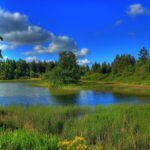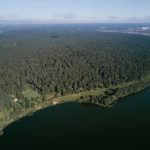Belousova A.P., Rudenko E.E., Vlasov K.G. Use of a Numerical Experiment in Studying the Migration of Different Pollutants in the Groundwater of the Kaluga Region in the Area of the Radioactive Trace // Ecosystems: ecology and dynamics. No 2. 2023. P. 40-72. | Abstract | PDF | Reference
- Summer forest in Central Russia (source: https://funart.pro/18502-lesa-rossii-61-foto.html)
- The Oka River in Kaluga City (source: https://funart.pro/71382-reka-oka-v-kaluge-74-foto.html)
- The Ugra River in Kaluga City (source: https://funart.pro/71382-reka-oka-v-kaluge-74-foto.html)
- The Tarusa River in Kaluga Region (source: https://funart.pro/71382-reka-oka-v-kaluge-74-foto.html)
- The Ugra River in Kaluga Region (source: https://funart.pro/71382-reka-oka-v-kaluge-74-foto.html)
- Park “Ugra” in Tovarkovo Settlement, Kaluga Region (source: https://funart.pro/71382-reka-oka-v-kaluge-74-foto.html)
- High water of the Oka River during early spring (source: https://funart.pro/71382-reka-oka-v-kaluge-74-foto.html)
The purpose of this article was to use a mathematical modeling in order to study the migration of various pollutants, including radionuclides, from poorly sorbed to highly sorbed ones that travel from groundwater to pressure groundwater through a separating layer, an aquiclude, and has varying permeability. Among others, the field of hydrogeological researches performs search and exploration of groundwater deposits. Search is the first stage which is carried out in unexplored territories, followed by exploration, the second stage, which is performed in the promising territories that were revealed during the first stage.
Our studies follow the first stage, because the territories of our choice, located in the Kaluga Region and affected by the Chernobyl accident, were unexplored. We focused on studying the migration of pollutants from groundwater through the aquiclude of the pressure waters. The direction of our search was determined by the aquiclude’s ability to let the pollutants through, which is considered the most unfavorable conditions for groundwater, or its ability to keep the pollutants out, which is considered a favorable condition. However, both of these stages do not exist separately in natural and artificial conditions, because they simply merge together, but, in order to study that, a thorough geological and hydrogeological knowledge of the territory is needed, which we do not possess for the study area. Therefore, our research was carried for both stages: in the first one, the aquiclude was assumed to be permeable, while in the second one it was assumed impermeable.
For each stage, exploratory numerical experiments were carried out using mathematical modeling. The object of those studies was the part of the Kaluga Region, most affected by the accident at the Chernobyl nuclear power plant. Studies concerning the first stage have been already completed and published by our crew (Belousova, Rudenko, 2021a, 2021b), while the results of the second stage and generalizing results of both studies are presented in this article. We studied the migration of various pollutants, including radionuclides, from groundwater through an impermeable aquiclude to the confined aquifer. We used the same profiles that were studied in the first stage, but applied slightly modified scenarios and used different coefficients of pollutant sorption distribution (Kd).
Numerical experiments of the second stage were carried out according to the following scenarios: 1 – (1-3-1), 2 – (1-6-1), 3 – (1-10-1), 4 – (6-60-6), 5 – (26-260-26), 6 – (100-1000-100). The first digit is the Kd value (l/kg) in the 1st layer, the second digit – 2nd layer, the third digit – 3rd layer. This selection of coefficients was determined by the fact that their values were assigned to be higher in the aquiclude than in the upper and lower aquifers.
Each scenario was applied for two conditions: with and without radioactive decay. The starting condition was the contamination degree of groundwater, just like the contamination degree of the ground in the radioactive trace zone of the study area. However, such a spread of contamination by either radionuclides or other pollutants is not actually (in natural conditions) observed in the groundwater of this territory. Pollutant concentrations can be specified in g/l, maximum permissible concentration (MPC) and background concentrations, but we used MPC. Kd of various pollutants were selected from the known values for the Bryansk Region (Belousova, Rudenko, 2021a, 2021b); regarding radionuclides, the Kd values mainly refer to the unsaturated zone of contamination.
We established that the main factors forming the pollutant migration are the radioactive decay of the said pollutants, their sorption properties, and the hydrodynamic dispersion of groundwater flow, which, in turn, depends on the geological and hydrogeological conditions of the study area and the aquiclude permeability. The studied situation proves that aquicludes cannot ensure a full protection of pressure groundwater from pollution.
Keywords: groundwater, underground confined waters, modeling of migration processes, pollutant, radionuclides, sorption, radioactive decay.
Acknowledgments. We would like to thank Yu.V. Minyaeva who prepared materials for this article before her saddening demise.
Funding. This work was carried out for the Water Problems Institute of the Russian Academy of Sciences, No. FMWZ-2022-0002 “Research of Geoecological Processes in Hydrological Systems of Land, Formation of the Quality of Surface and Ground Waters, Problems of Water Resources Management and Water Use under Conditions of Climate Change and Anthropogenic Impacts”.
DOI: 10.24412/2542-2006-2023-2-40-72
EDN: UEXKOC

















